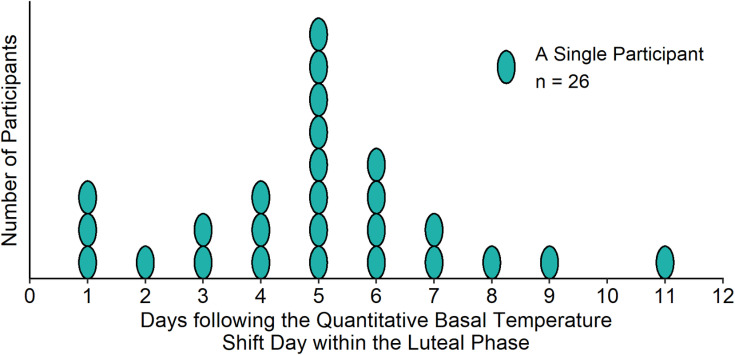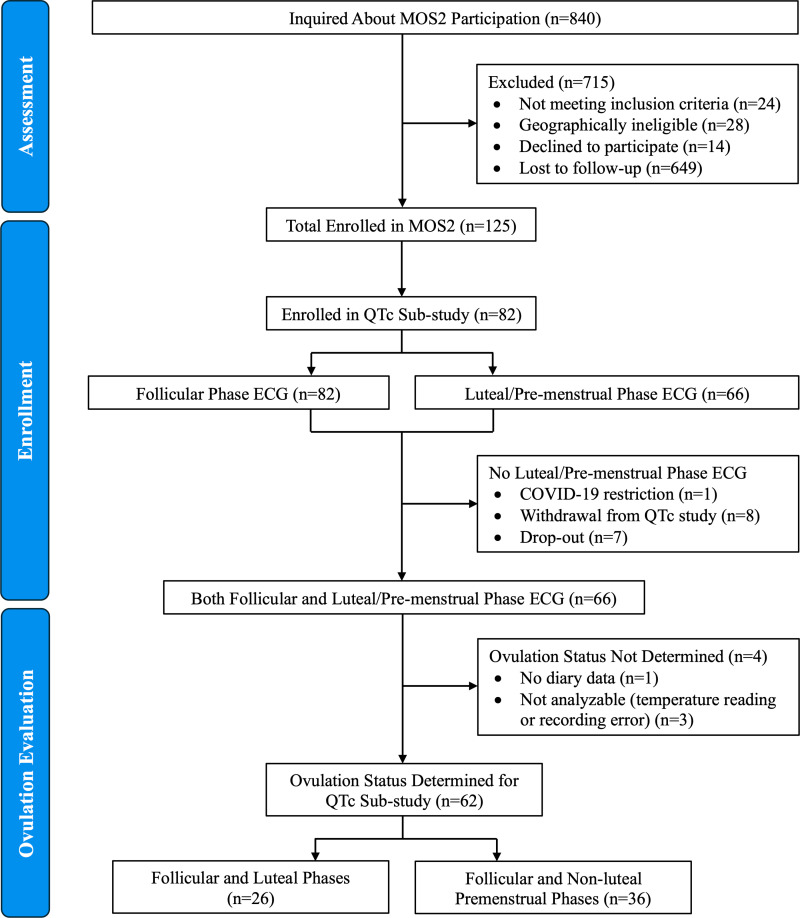Borna Naderi, Lauren Yee, Sonia Shirin, Jerilynn C Prior, Christopher Cheung, Brianna Davies, Andrew D Krahn
下载PDF
{"title":"排卵和不排卵周期阶段对月经周期QT间期动力学的影响。","authors":"Borna Naderi, Lauren Yee, Sonia Shirin, Jerilynn C Prior, Christopher Cheung, Brianna Davies, Andrew D Krahn","doi":"10.1371/journal.pone.0320846","DOIUrl":null,"url":null,"abstract":"<p><strong>Background: </strong>Ovarian hormones affect cardiovascular health yet few sufficient-sized studies with reliable ovulatory documentation have assessed the QTc-hormonal relationship. This study investigated QTc changes across ovulatory and anovulatory menstrual cycle phases.</p><p><strong>Methods: </strong>This prospective cohort investigation, a cardiac sub-study of the Menstruation and Ovulation Study 2 (MOS2), involved 62 healthy, regularly menstruating community-dwelling women during spontaneous menstrual cycles. Electrocardiographic recordings were obtained within-woman during different cycle phases: mid-follicular for all, and luteal (ovulatory) or premenstrual (anovulatory), documented by the validated Quantitative Basal Temperature© method. Fridericia's formula rate-corrected the QT interval (QTc). A subsequent meta-analysis was conducted, pooling data from three additional studies to evaluate ovulatory follicular-luteal phase QTc changes.</p><p><strong>Results: </strong>In the 26 ovulatory cycles, QTc minimally decreased from the mid-follicular to the luteal phases (383.0 ± 12.8 vs 382.6 ± 12.8 msec, P = .859). QTc in the 36 anovulatory cycles tended to increase from mid-follicular to premenstrual phases (381.7 ± 13.1 vs 385.0 ± 16.1 msec, P = .166). The meta-analysis in ovulatory cycles yielded a random-effects weighted mean QTc shortening of 1.67 msec (P = .53) in the luteal vs the follicular phase, aligning with our cohort data.</p><p><strong>Conclusion: </strong>In confirmed ovulatory cycles, QTc changes were minimal, showing no meaningful luteal phase QTc shortening. QTc changes in anovulatory cycles were also insignificant, with a small QTc prolongation likely due to longer estradiol exposure not counterbalanced by progesterone. Under normal physiological conditions, QTc changes during the menstrual cycle are trivial, and menstrual status does not need to be considered when interpreting the QT interval.</p>","PeriodicalId":20189,"journal":{"name":"PLoS ONE","volume":"20 5","pages":"e0320846"},"PeriodicalIF":2.6000,"publicationDate":"2025-05-16","publicationTypes":"Journal Article","fieldsOfStudy":null,"isOpenAccess":false,"openAccessPdf":"https://www.ncbi.nlm.nih.gov/pmc/articles/PMC12083801/pdf/","citationCount":"0","resultStr":"{\"title\":\"Ovulatory and anovulatory cycle phase influences on QT interval dynamics during the menstrual cycle.\",\"authors\":\"Borna Naderi, Lauren Yee, Sonia Shirin, Jerilynn C Prior, Christopher Cheung, Brianna Davies, Andrew D Krahn\",\"doi\":\"10.1371/journal.pone.0320846\",\"DOIUrl\":null,\"url\":null,\"abstract\":\"<p><strong>Background: </strong>Ovarian hormones affect cardiovascular health yet few sufficient-sized studies with reliable ovulatory documentation have assessed the QTc-hormonal relationship. This study investigated QTc changes across ovulatory and anovulatory menstrual cycle phases.</p><p><strong>Methods: </strong>This prospective cohort investigation, a cardiac sub-study of the Menstruation and Ovulation Study 2 (MOS2), involved 62 healthy, regularly menstruating community-dwelling women during spontaneous menstrual cycles. Electrocardiographic recordings were obtained within-woman during different cycle phases: mid-follicular for all, and luteal (ovulatory) or premenstrual (anovulatory), documented by the validated Quantitative Basal Temperature© method. Fridericia's formula rate-corrected the QT interval (QTc). A subsequent meta-analysis was conducted, pooling data from three additional studies to evaluate ovulatory follicular-luteal phase QTc changes.</p><p><strong>Results: </strong>In the 26 ovulatory cycles, QTc minimally decreased from the mid-follicular to the luteal phases (383.0 ± 12.8 vs 382.6 ± 12.8 msec, P = .859). QTc in the 36 anovulatory cycles tended to increase from mid-follicular to premenstrual phases (381.7 ± 13.1 vs 385.0 ± 16.1 msec, P = .166). The meta-analysis in ovulatory cycles yielded a random-effects weighted mean QTc shortening of 1.67 msec (P = .53) in the luteal vs the follicular phase, aligning with our cohort data.</p><p><strong>Conclusion: </strong>In confirmed ovulatory cycles, QTc changes were minimal, showing no meaningful luteal phase QTc shortening. QTc changes in anovulatory cycles were also insignificant, with a small QTc prolongation likely due to longer estradiol exposure not counterbalanced by progesterone. Under normal physiological conditions, QTc changes during the menstrual cycle are trivial, and menstrual status does not need to be considered when interpreting the QT interval.</p>\",\"PeriodicalId\":20189,\"journal\":{\"name\":\"PLoS ONE\",\"volume\":\"20 5\",\"pages\":\"e0320846\"},\"PeriodicalIF\":2.6000,\"publicationDate\":\"2025-05-16\",\"publicationTypes\":\"Journal Article\",\"fieldsOfStudy\":null,\"isOpenAccess\":false,\"openAccessPdf\":\"https://www.ncbi.nlm.nih.gov/pmc/articles/PMC12083801/pdf/\",\"citationCount\":\"0\",\"resultStr\":null,\"platform\":\"Semanticscholar\",\"paperid\":null,\"PeriodicalName\":\"PLoS ONE\",\"FirstCategoryId\":\"103\",\"ListUrlMain\":\"https://doi.org/10.1371/journal.pone.0320846\",\"RegionNum\":3,\"RegionCategory\":\"综合性期刊\",\"ArticlePicture\":[],\"TitleCN\":null,\"AbstractTextCN\":null,\"PMCID\":null,\"EPubDate\":\"2025/1/1 0:00:00\",\"PubModel\":\"eCollection\",\"JCR\":\"Q1\",\"JCRName\":\"MULTIDISCIPLINARY SCIENCES\",\"Score\":null,\"Total\":0}","platform":"Semanticscholar","paperid":null,"PeriodicalName":"PLoS ONE","FirstCategoryId":"103","ListUrlMain":"https://doi.org/10.1371/journal.pone.0320846","RegionNum":3,"RegionCategory":"综合性期刊","ArticlePicture":[],"TitleCN":null,"AbstractTextCN":null,"PMCID":null,"EPubDate":"2025/1/1 0:00:00","PubModel":"eCollection","JCR":"Q1","JCRName":"MULTIDISCIPLINARY SCIENCES","Score":null,"Total":0}
引用次数: 0
引用
批量引用
Ovulatory and anovulatory cycle phase influences on QT interval dynamics during the menstrual cycle.
Background: Ovarian hormones affect cardiovascular health yet few sufficient-sized studies with reliable ovulatory documentation have assessed the QTc-hormonal relationship. This study investigated QTc changes across ovulatory and anovulatory menstrual cycle phases.
Methods: This prospective cohort investigation, a cardiac sub-study of the Menstruation and Ovulation Study 2 (MOS2), involved 62 healthy, regularly menstruating community-dwelling women during spontaneous menstrual cycles. Electrocardiographic recordings were obtained within-woman during different cycle phases: mid-follicular for all, and luteal (ovulatory) or premenstrual (anovulatory), documented by the validated Quantitative Basal Temperature© method. Fridericia's formula rate-corrected the QT interval (QTc). A subsequent meta-analysis was conducted, pooling data from three additional studies to evaluate ovulatory follicular-luteal phase QTc changes.
Results: In the 26 ovulatory cycles, QTc minimally decreased from the mid-follicular to the luteal phases (383.0 ± 12.8 vs 382.6 ± 12.8 msec, P = .859). QTc in the 36 anovulatory cycles tended to increase from mid-follicular to premenstrual phases (381.7 ± 13.1 vs 385.0 ± 16.1 msec, P = .166). The meta-analysis in ovulatory cycles yielded a random-effects weighted mean QTc shortening of 1.67 msec (P = .53) in the luteal vs the follicular phase, aligning with our cohort data.
Conclusion: In confirmed ovulatory cycles, QTc changes were minimal, showing no meaningful luteal phase QTc shortening. QTc changes in anovulatory cycles were also insignificant, with a small QTc prolongation likely due to longer estradiol exposure not counterbalanced by progesterone. Under normal physiological conditions, QTc changes during the menstrual cycle are trivial, and menstrual status does not need to be considered when interpreting the QT interval.




 求助内容:
求助内容: 应助结果提醒方式:
应助结果提醒方式:


